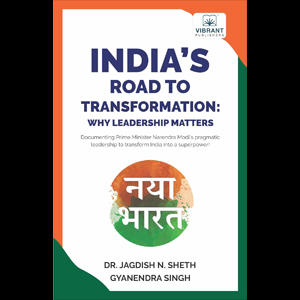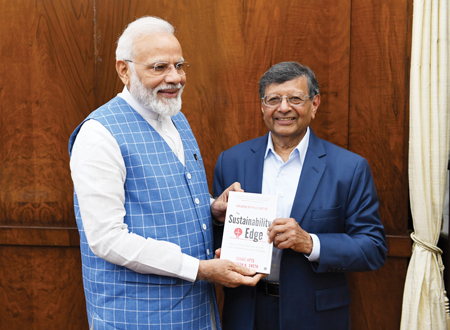Books: A Deep Dive into What Makes a Transformational Leader

In his latest book, thought leader and Padma Bhushan awardee DR. JAGDISH SHETH provides a scholarly analytical study of the leadership qualities of the historic and contemporary heads of nations and, drawing from those lessons, identifies Prime Minister Narendra Modi as a transformational leader who India needs to continue on the path of development and economic progress.
The following is a review of the book and an interview with Dr. Sheth.
In 2016, in a cover story titled “More Than a Billion Hopes,” I had asked in these pages of Khabar magazine whether India’s economic promise would be “delivered or derailed.” I was exploring whether hope might finally overcome hype at the dawn of what many saw as a new era in Indian politics. Prime Minister Narendra Modi had come to power two years before, promising to continue the brand of reform that had powered a season of unprecedented growth in Gujarat during his decade as the chief minister.
It was a heady time, with the new PM and his Bharatiya Janata Party-led NDA coalition announcing sweeping initiatives designed to remake an economy that was suffering from inefficient infrastructure and facing a bureaucratic overhang even 20-plus years after the country’s economic liberalization and the dismantling of the so-called “license permit raj.” Modi pledged to catapult India into a new economic stratum, leading the country into an international standing befitting what would soon become the world’s most populous nation.
This new book by the renowned Emory University marketing scholar Jagdish Sheth and his late colleague and friend Gyanendra Singh, a former Procter & Gamble executive and scholar from Northwestern’s Kellogg School of Business, is a referendum on Modi’s first 10 years of national leadership — and an apology for why a third term was necessary to finish the work he had started.
The authors conclude that this prime minister is the only man for the job in India’s fragmented political landscape, especially given what they view as a historical precedent: nation-building, they argue from history, requires dogged persistence and a steady hand with a transformational leader staying, on average, 15 years or more at the helm.
The book offers arguments based on studying other nations (or empires) that have enjoyed economic dynamism—from authoritarian systems like China under Deng Xiaoping to democracies like post-Cold War Germany under Helmut Kohl. They note that even Franklin Delano Roosevelt, elected four times during a period of economic upheaval in the 20th-century United States, needed time to push through his New Deal policies. More recently, the so-called Asian Tigers—smaller economies like Singapore, South Korea, and Taiwan—achieved breakneck modernization through economic policy liberalization.
The authors also mine the millennia for leadership lessons, reaching back thousands of years to Genghis Khan and Alexander the Great before flashing forward to France’s Napoleonic era and the post-Ottoman transformation of Turkey under Mustafa Kemal Ataturk. They concede that Modi may not have earned his place among such a pantheon yet, but they more than insinuate that the prime minister could be a similarly impactful force for modern India.
However, these sweeping comparisons fail to demonstrate how these lessons apply to India–a diverse civilization and a relatively new nation with its unique past and projected strengths, which the authors ably point out in many places.
 Perhaps the least accessible section in an otherwise highly readable book is the breakdown between the types of leaders, from situational to transformational, explaining the characteristics that separate the latter from the former: charisma, energy, vision, and determination. Pragmatism is positioned as the paramount virtue, enabling leaders to balance practical reform and political survival. These leaders, the authors argue, gather buy-in from the public by showcasing tangible progress that builds toward an unyielding vision.
Perhaps the least accessible section in an otherwise highly readable book is the breakdown between the types of leaders, from situational to transformational, explaining the characteristics that separate the latter from the former: charisma, energy, vision, and determination. Pragmatism is positioned as the paramount virtue, enabling leaders to balance practical reform and political survival. These leaders, the authors argue, gather buy-in from the public by showcasing tangible progress that builds toward an unyielding vision.
[Right] India’s Road to Transformation: Why Leadership Matters By Jagdish N. Sheth and Gyanendra Singh Vibrant Publishers, 2024.
Still, a seeming contradiction emerges in the book over the issue of cultural identity and nationalism. The authors cite Mahatma Gandhi’s admonitions against exclusion in the quest to build a unified Indian identity; yet in the same breath, use Modi’s actions on some of the most divisive communal issues, from the Citizenship Amendment Act (CAA) to the opening of the Ram mandir, somehow as evidence of his role as a unifier. They also assert that the opposition I.N.D.I.A. coalition, led by the Congress Party, is guilty of using identity politics as a wedge, but they fail to critically examine the way Modi has used sharp rhetoric against Muslims to shore up his own Hindu nationalist base.
Much of the book’s practical value lies in its quantitative analysis of India’s historical performance—where the country has fallen behind under previous leaders and just how much Modi has built on the halting progress of the past. While founding prime minister Jawaharlal Nehru (16 years) and later, Indira Gandhi (15 years over two separate terms), helped establish India as a young nation and unleash its agricultural prowess, they also embraced heavy state intervention in strategic sectors, an approach modeled after the Soviet Union, India’s close ally in those times. This held the country back, the authors argue, as China, India’s repeated foil in the book, soared under the reform and opening policies of Deng Xiaoping starting in 1979.
Even without a majority in the upper house, Modi used his political capital to push through reforms like the Goods and Services Tax, changes to bankruptcy laws, and demonetization to unlock a new era of growth. He drew record foreign investment, developed India’s manufacturing muscle, and rapidly built infrastructure while leading millions out of poverty and growing a massive middle class. This coincided with a push to bring individuals and businesses into the formal economy, reduce tax evasion, and enable India to shore up its finances.
As the book’s middle chapters relentlessly point out, Modi, by most metrics, has outperformed any modern democratic leader on the economic front, putting India in a category by itself by averaging more than 7 percent GDP growth in the first 10 years of his rule. The authors argue that Modi’s unapologetic leadership has bolstered India’s internal confidence and external reputation.
Released during the peak of the Indian election season and peppered with unveiled statements of support, the reader may be forgiven for believing the book to be politically inclined, but it’s difficult to challenge its central argument: that a nation at such a geopolitical inflection point needs a chance to continue along its path of proven progress.
Q & A With Dr. Jagdish Sheth
(Edited from a transcript of a verbal interview for clarity, length, and flow.)
This book could be read as a prescription for government officials, but you took a management angle. What leadership lessons can business leaders glean from the historical examples you cite?
Our notion was that the study of leadership in the corporate world is done quite a lot, but leadership at a national level is much more complicated. If you know how to manage or transform a nation—a much more difficult task, with so many uncertainties and so much unpredictability—you will be a better corporate CEO.
When we started, we thought corporate leadership would tell us how to build nations, and then we became fascinated by history. Even though I majored in psychology and business, I love history and biographies, particularly of emperors [and national leaders], so I told [my late co-author] Gyanendra Singh: let’s work on looking at the historical precedent of transformative leaders. It was fascinating to find this incredible set of historical people.
How did you learn that transformative leaders need, loosely speaking, 15 years of rule to make an impact? You cite many examples, such as FDR, Lee Kwan Yew of Singapore, and some of the chancellors of the unified Germany in the post-Soviet period. Was that just a happy discovery?
We discovered that while you can reform a nation in one term—four or five years—true transformation requires a minimum of about 15 years. During that time, there must be political stability, not just continuity. In the ‘80s, Japan continued with the same party, if not the same leader, over a long time. Mexico had a long, uninterrupted same-party rule. India had the Congress Party at the time. In the Soviet Union, Gorbachev came to power but, unfortunately, he chose the wrong model by pursuing political reforms first, as opposed to economic and social reforms.
Another thing we found was that it doesn’t matter whether the government is autocratic, dictatorial, or democratic; it seems to work. Whether in established economies like the U.S. or emerging economies
like China, transformative leaders are all very pragmatic people with good communication skills. To build a new edifice or structure, you need an architect on one hand and a builder on the other. Most of these leaders were both.
How important is leadership continuity?
There are two answers. One is that there will be continuity because of technology. No matter which party wins, none of them will abandon platforms like Aadhaar, United Payments Interface, or other technologies. Technology evolution tends to be independent and a leading indicator, while regulation lags. No matter which party comes, technology will go ahead—it’s leapfrogging.
The second answer is that each party has a different ideology. If a Congress-led coalition government had come into power, it would have prioritized the social agenda over the economic agenda—in other words, more subsidization. Even though the reforms of 1991 were under Congress, they didn’t do much with them. They could have ramped up more liberalization and allowed foreign competition to come in a big way, for example.
Now that the BJP-led coalition government has won, India will continue with economic reform first, followed by social reforms and, ultimately, political reforms, which are the hardest in any country.
 [Left] Dr. Jagdish Sheth with Prime Minister Narendra Modi.
[Left] Dr. Jagdish Sheth with Prime Minister Narendra Modi.
You know Prime Minister Modi personally. How would you counter criticism that this book was an endorsement of Modi or an effort to help him get re-elected, particularly given the release timing?
The release timing had something to do with [the health of] my colleague. My passion is leadership, and surprisingly, Modi, with 76 percent popularity within the country, ranks No. 1 in popularity among global leaders. The real reason for my admiration of Modi is what he did for the state of Gujarat, where I met him. He transformed it completely. The reform he made in the electricity sector, from no response by the government bureaucrats to [ensuring speedy solutions] takes somebody operating as a CEO.
What are the core characteristics of a transformational leader versus those that are situational or transactional?
Situational leaders arise because of a crisis. For example, in Ukraine, a stand-up comedian became the president. The job of such leaders is to manage crises. They can’t think about the future; it’s a survival game at that time. Transactional leaders—the best example in American history was Lyndon Johnson. A brilliant negotiator, he knew how to make deals. But that doesn’t move the nation ahead.
Transformational leadership is very important in India because the generation gap is now only eight years due to the acceleration of change. The older sister cannot relate to the younger sister in terms of lifestyle and basic family values. With this rapid change, people don’t think they belong to the nation where they grew up; it is alien to them, which is an idea I’m very worried about.
How do you define nation-building for the purpose of the book? Isn’t democracy just nation-building over the long haul?
Nation-building is a continuous process, and sometimes, a successful nation plateaus. That’s the worry about many of the European countries that were so successful, essentially reborn after World War II—they have plateaued. They don’t know where to go.
You need to create new hope and new aspirations. Otherwise, status-quo management makes you fail even more. When that happens, the leader is thrown out and the party is thrown out. Being an incumbent used to be an advantage, but it’s actually a liability right now.
The question for leaders is: Can you inspire the people? Can you give them hope? And then, can you execute to fulfill those aspirations and hope? People like future-positive leaders. They want themselves and their children to be better off. They don’t have the luxury of time because technology has made us do everything so fast. There has to be a sense of urgency that is mission-driven.
J. Trevor Williams is the managing editor of Global Atlanta, an online news service covering Atlanta’s connections with the world. A versatile digital journalist, Trevor has spent 15+ years writing on international business and trade, undertaking reporting trips to 30+ countries on five continents, including two to India.
Enjoyed reading Khabar magazine? Subscribe to Khabar and get a full digital copy of this Indian-American community magazine.
blog comments powered by Disqus











